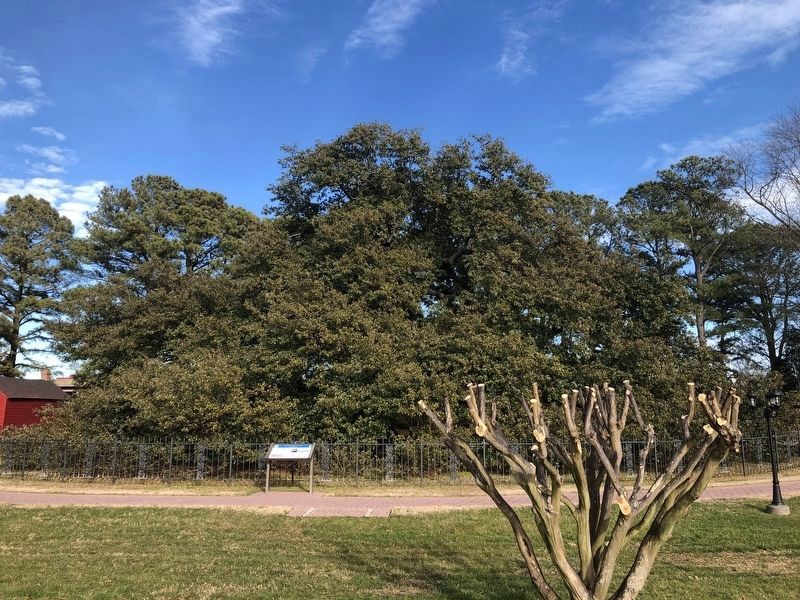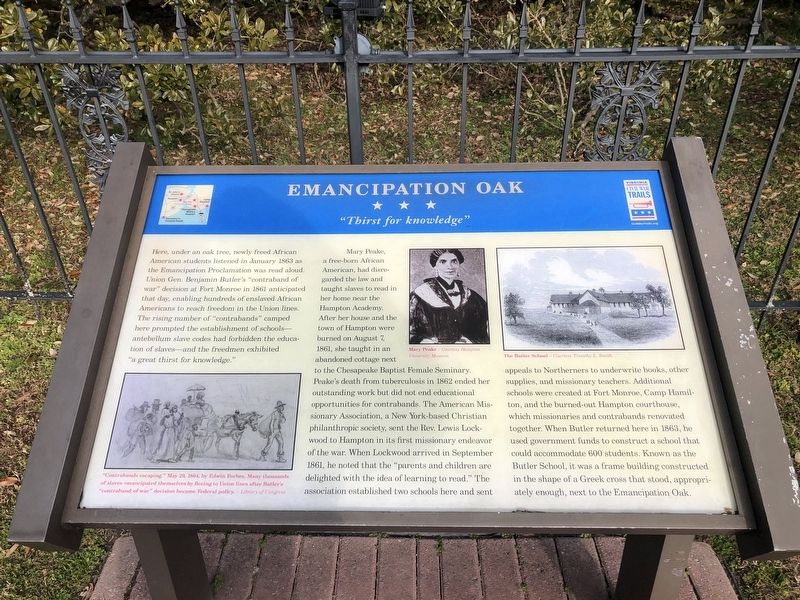Emancipation Oak
"Thirst for knowledge"
Here, under an oak tree, newly freed African American students listened in January 1863 as the Emancipation Proclamation was read aloud. Union Gen. Benjamin Butler's "contraband of war" decision at Fort Monroe in 1861 anticipated that day, enabling hundreds of enslaved African Americans to reach freedom in the Union lines. The rising number of "contrabands" camped here prompted the establishment of schools—antebellum slave codes had forbidden the education of slaves—and the freedmen exhibited "a great thirst for knowledge."
Mary Peake, a free-born African American, had disregarded the law and taught slaves to read in her home near the Hampton Academy. After her house and the town of Hampton were burned on August 7, 1861, she taught in an abandoned cottage next to the Chesapeake Baptist Female Seminary. Peake's death from tuberculosis in 1862 ended her outstanding work but did not end educational opportunities for contrabands. The American Missionary Association, a New York-based Christian philanthropic society, sent the Rev. Lewis Lockwood to Hampton in its first missionary endeavor of the war. When Lockwood arrived in September 1861, he noted that the "parent and children are delighted with the idea of learning to read." The association established two schools here and sent appeals to Northerners to underwrite
books, other supplies, and missionary teachers. Additional schools were created at Fort Monroe, Camp Hamilton, and the burned-out Hampton courthouse, which missionaries and contrabands renovated together. When Butler returned here in 1863, he used government funds to construct a school that could accommodate 600 student. Known as the Butler School, it was a frame building constructed in the shape of a Greek cross that stood, appropriately enough, next to the Emancipation Oak.
[Captions:]
"Contrabands escaping." May 29, 1864, by Edwin Forbes. Many thousands of slaves emancipated themselves by fleeing to Union lines after Butler's "contraband of war" decision became Federal policy. — Library of Congress
Erected by Virginia Civil War Trails.
Topics and series. This historical marker is listed in these topic lists: African Americans • Education • War, US Civil. In addition, it is included in the Historically Black Colleges and Universities, and the Virginia Civil War Trails series lists. A significant historical month for this entry is January 1863.
Location. 37° 1.385′ N, 76° 19.833′ W. Marker is in Hampton, Virginia. It is in Phoebus. Marker is on Emancipation Drive just south of William R. Harvey Way, on the right when traveling south

Other nearby markers. At least 8 other markers are within walking distance of this marker. Hampton Institute (a few steps from this marker); a different marker also named Emancipation Oak (within shouting distance of this marker); John Baptist Pierce (about 300 feet away, measured in a direct line); Phoebus (approx. 0.2 miles away); Second Church at Kecoughtan (approx. ¼ mile away); First Church at Kecoughtan (approx. ¼ mile away); This Wall (approx. ¼ mile away); Second Church at Kecoughton (approx. ¼ mile away). Touch for a list and map of all markers in Hampton.
Related marker. Click here for another marker that is related to this marker. This marker has replaced the linked marker. It has different formatting and slightly different content.
Credits. This page was last revised on February 1, 2023. It was originally submitted on February 8, 2021, by Devry Becker Jones of Washington, District of Columbia. This page has been viewed 182 times since then and 34 times this year. Photos: 1, 2. submitted on February 8, 2021, by Devry Becker Jones of Washington, District of Columbia.
